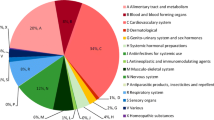Abstract
Aim: To compare completeness and quality of orders written before and after introduction of a preprinted medication order form for investigational drugs. Completeness of physician's orders for investigational drugs was compared during two successive periods: before and after implementation of a preprinted form for these orders.
Method: Orders were checked for six elements: pharmaceutical company's identity, protocol's name, patient's identity (i.e., initials), investigator's signature, order's date, and drug designation. Each element was categorized according to three quality criteria: mistake (wrong information), omission, or imprecision (incomplete information). A total of 536 orders were evaluated corresponding to 268 orders and to 4824 quality criteria in each period.
Results: During the baseline study, 228 (85%) problematic prescriptions were detected. Of the 4824 quality criteria evaluated, 422 (8.7%) errors were recorded. Common types of errors were omission of pharmaceutical company's identity, mistaken protocol name, and omission of patient's identity. After the introduction of the order form, 13 (4.9%) prescriptions contained errors. Fifteen (0.3%) quality criteria were not in conformity with the standard. The common types of errors were omission of patient's identity and order date. Physician's orders for investigational drugs are more complete when they use a preprinted prescription form than when they use traditional orders.
Conclusion: The introduction of a preprinted order form for investigational drugs prevents potential medication errors and contributes to patients' safety.
Similar content being viewed by others
References
Ministère des Affaires Sociales. Code de la santé publique. Livre V. Ordonnance no. 2000–548 articles L.1121-L.1122, articles L.5126–11–5126–12; Annecy, France: Tissot, 2000.
Ministère de la santé et de la famille. Bonnes pratiques cliniques. 1987.
Décret no. 2000–1316 du 26 décembre 2000 relatif aux pharmacies à usage intérieur. J Off Repub Fr 2000; 302: 20954–61.
Directive européenne n° 2001/20/CE du 4 avril 2001 relative aux essais cliniques des médicaments à usage humain. J Off Commu Eu 2001; L121: 34–44.
ASHP guidelines on clinical drug research. Am J Health Syst Pharm 1998; 55: 369–76.
Favier M, Bressolle F. Preventing medication errors in antineoplastic therapy. Am J Hosp Pharm 1994; 51: 832–3.
Doroty L, Chipley Hancock, Michelle M. Use of medication orders for monitoring prescribing and documenting consultations. Am J Hosp Pharm 1992; 49: 2215–7.
Thorn DB, Sexton MG et al. Effect of a cancer chemotherapy prescription form on prescription completeness. Am J Hosp Pharm 1989; 46: 1802–6.
Blum KV, Abel SR et al. Medication error prevention by pharmacists. Am J Hosp Pharm 1988; 45: 1902–3.
Author information
Authors and Affiliations
Rights and permissions
About this article
Cite this article
Ollivier, V., Thelcide, C., Simon, C. et al. Standardized order form for investigational drugs: effect on completeness of the prescription. Pharm World Sci 26, 178–179 (2004). https://doi.org/10.1023/B:PHAR.0000026801.14162.3c
Issue Date:
DOI: https://doi.org/10.1023/B:PHAR.0000026801.14162.3c



